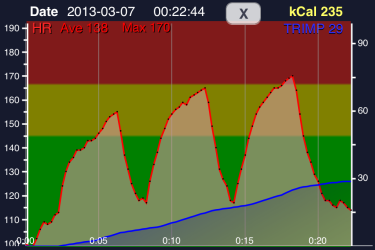by Simon Wegerif
As you may know from a recent blog post exploring threshold and polarised training gains I agreed to start a polarised training programme in my training ahead of the Etape. To get started I began with the 4 minute/2 minute zone 3/zone 1 workout structure.
This screenshot from Precision Pulse shows my first attempt at Zone 3 intervals. After a brief warm up on the garage turbo-trainer, I raised the effort level to near maximum (RPE 8/10) and as you can see my heart rate increased rapidly, and was still increasing at the end of the first 4 min interval. After precisely 2 mins of easy peddling, I raised the effort level again, and the max HR reached was a little higher this time, close to the top end of Zone 2. After another 2 mins easy, the 3rd interval finally broke through into Zone 3, and again was still increasing at the end of the interval.

Although the effort (RPE) was high for each interval, this test showed me that the intensity required is very high, and 4 mins is probably a stretch target for me to maintain!


I see on the product page that it notes aerobic and anaerobic zones. How does it go about determining those zones?
Hi Steve,
Upper limit of the aerobic Zone 1 (VT1) is approximated using Dr Phil Maffetone’s 180 formula (with his permission). The anaerobic Zone 3 threshold (VT2) is approximated using 88% of actual or age derived max HR (depending on whether the user knows their max HR).
I know my thresholds from lab testing, and the VT1 was a few bpm higher than the formula predicted, whereas the VT2 was spot on.
What should I look for in a lab test such as you got? Want to make sure I get good results by picking the correct lab.
My tests were done in a University physiology lab using a gas metabolic cart with face mask, which allows them to find the first & second ventilatory thresholds accurately.
I believe its possible to get good results from a simple lactate testing kit, but you need multiple samples to find the two inflexion points.
I think there are a number of specialist testing centres that provide these services now, or there might be a trial you can join at a local Uni where you would get the results for free.